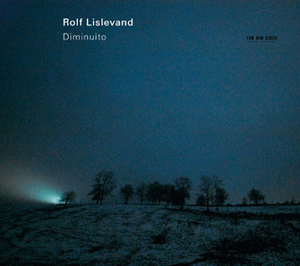 Rolf Lislevand, in his essay accompanying Diminuito, says that this collection is about the Italian renaissance, “how it understood itself, how we understand it today, and how we would have understood it if we had been contemporary with it.” That’s rather a tall order.
Rolf Lislevand, in his essay accompanying Diminuito, says that this collection is about the Italian renaissance, “how it understood itself, how we understand it today, and how we would have understood it if we had been contemporary with it.” That’s rather a tall order.
The key concept seems to be the idea of “diminutions,” a method of transforming a relatively simple melody into a much more elaborate and highly colored melody — in other words, ornamentation. The focus is the plucked string, which, as Lislevand points out, lacks the continuity of the human voice or a bowed instrument: once the note is plucked, it takes on its own life and is no longer amenable to control by the performer. Diminutions were an attempt to extend the player’s control, to provide that continuity that the plucked note lacked. The ensemble underscores this by adding vocal lines in conjunction with the solo instruments — usually lute, but also including vihuela de mano, harp, and nyckelharpa, supported by clavichord and organ.
It took some careful listening, but I think I do have a different idea of the renaissance — at least, of its music — than I did. The first three tracks seemed pretty much standard-issue “early music,” but things began to slip into a different groove with “Petit Jacquet,” in a version by Giovanni Antonio Terzi, coupled with “Quinta pars” from Diego Ortiz, and very much with “La perra mora” by that famous composer, Anonymous. This last is a particularly vivid example of what I think Lislevand is aiming for, with its fusion of lute, colascione, triple harp, and I’m not sure what else, set in some surprising rhythmic structures. As Lislevand puts it, “A vocal piece in 5/2 time with an unbelievable modern groove. . . !” And unbelievably modern it is, with a strong element of what we would call today “world music,” and yet it never loses that renaissance flavor. (I especially liked the little drum flourish that finishes the piece.)
Let me point out as well that there’s a fair amount of improvisation going on here, which Lislevand refers to and which is apparent when one begins to get into the structure of the music: there are decisions being made en route, as it were, that lead to some very happy destinations.
With those clues, and my ears finally tuned to what was something I had thought I knew, the whole album took on a much richer dimension. I’m one of those who is firmly convinced that any art must have a strong emotional component, something that’s going to reach past our normal defenses and go right for the gut. I would be the last to say, however, that having an intellectual understanding of what the experience includes is going to detract at all — quite the opposite. As I’ve said in the past, especially in relation to other music, when the intellectual foundation is clear, the experience is much more than it might have been otherwise, and I think Lislevand and his ensemble have made that very plain in this collection.
So, Diminuito became much more than a collection of Renaissance songs, which in itself would have been good enough — the material is engaging, and the musicians are right together on it, no matter how tricky it gets. (And these are some amazing performances, be sure of it.) And if you listen carefully, you can learn something about how the renaissance sounded from that side of history.
The performers are: Rolf Lislevand, lutes, vihuela de mano; Linn Andrea Fugiseth, voice; Anna Maria Friman, voice; Giovanna Pessi, triple harp; Marco Ambrosini, nyckelharpa; Thor-Harald Johnsen, chitarra battente, vihuela de mano, lutes; Michael Behringer, clavichord, organ; Bjørn Kjellemyr, colascione; David Mayoral, percussion.
(ECM Records, 2009)
